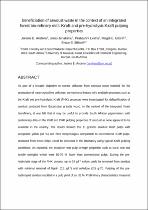 ResearchSpace
ResearchSpace
Beneficiation of sawdust waste in the context of an integrated forest bio-refinery mill: Kraft and pre-hydrolysis Kraft pulping properties
JavaScript is disabled for your browser. Some features of this site may not work without it.
- ResearchSpace
- →
- Research Publications/Outputs
- →
- Book Chapters
- →
- View Item
| dc.contributor.author |
Andrew, JE

|
|
| dc.contributor.author |
Johakimu, Jonas K

|
|
| dc.contributor.author |
Lekha, P

|
|
| dc.contributor.author |
Gibril, ME

|
|
| dc.contributor.author |
Sithole, Bishop B

|
|
| dc.date.accessioned | 2019-03-23T13:37:07Z | |
| dc.date.available | 2019-03-23T13:37:07Z | |
| dc.date.issued | 2018 | |
| dc.identifier.citation | Andrew, J.E. et al. 2018. Beneficiation of sawdust waste in the context of an integrated forest bio-refinery mill: Kraft and pre-hydrolysis Kraft pulping properties. Opportunities for Biomass and Organic Waste Valorisation: Finding Alternative Solutions to Disposal in South Africa, pp. 123-138 | en_US |
| dc.identifier.isbn | 978-77615-010-6 | |
| dc.identifier.uri | http://hdl.handle.net/10204/10831 | |
| dc.description | Copyright: 2018 UNISA. Due to copyright restrictions, the attached PDF file contains the preprint version of the published item. For access to the published version, please consult the publisher's website. | en_US |
| dc.description.abstract | As part of a broader objective to extract cellulose from sawdust waste material for the production of nano-crystalline cellulose, conventional industrially available processes such as the Kraft and pre-hydrolysis Kraft (PHK) processes were investigated for delignification of sawdust produced from Eucalyptus grandis wood. In the context of the integrated forest biorefinery, it was felt that it may be useful to provide South African papermakers with preliminary data on the Kraft and PHK pulping properties of sawdust as none appeared to be available in the country. The results showed that E. grandis sawdust Kraft pulps with acceptable yields (48 %) and fibre morphologies comparable to conventional Kraft pulps, produced from wood chips, could be produced in the laboratory using typical Kraft pulping conditions. As expected, the exception was pulp strength properties such as burst, tear and tensile strengths which were 50-70 % lower than conventional pulps. During the pre-hydrolysis stage of the PHK process, up to 24 g.l-1 xylose could be removed from sawdust with minimal removal of lignin (0.1 g.l-1) and cellulose (2.5 g.l-1). Pulping of the pre-hydrolysed sawdust resulted in a pulp yield of ca. 35 %. Preliminary characteristics measured on the unbleached PHK sawdust pulp such as pentosan content (3-4 %), brightness (41 %) and viscosity (760 – 850 ml.g-1) alluded to its potential for the production of dissolving pulp. | en_US |
| dc.language.iso | en | en_US |
| dc.publisher | UNISA | en_US |
| dc.relation.ispartofseries | Worklist;17780 | |
| dc.subject | Biorefineries | en_US |
| dc.subject | Sawdust | en_US |
| dc.subject | Kraft pulp | en_US |
| dc.subject | Pre-hydrolysis Kraft | en_US |
| dc.subject | Nano-crystalline cellulose | en_US |
| dc.title | Beneficiation of sawdust waste in the context of an integrated forest bio-refinery mill: Kraft and pre-hydrolysis Kraft pulping properties | en_US |
| dc.type | Book Chapter | en_US |
| dc.identifier.apacitation | Andrew, J., Johakimu, J. K., Lekha, P., Gibril, M., & Sithole, B. B. (2018). Beneficiation of sawdust waste in the context of an integrated forest bio-Refinery mill: Kraft and pre-Hydrolysis Kraft pulping properties., <i>Worklist;17780</i> UNISA. http://hdl.handle.net/10204/10831 | en_ZA |
| dc.identifier.chicagocitation | Andrew, JE, Jonas K Johakimu, P Lekha, ME Gibril, and Bishop B Sithole. "Beneficiation of sawdust waste in the context of an integrated forest bio-refinery mill: Kraft and pre-hydrolysis Kraft pulping properties" In <i>WORKLIST;17780</i>, n.p.: UNISA. 2018. http://hdl.handle.net/10204/10831. | en_ZA |
| dc.identifier.vancouvercitation | Andrew J, Johakimu JK, Lekha P, Gibril M, Sithole BB. Beneficiation of sawdust waste in the context of an integrated forest bio-refinery mill: Kraft and pre-hydrolysis Kraft pulping properties.. Worklist;17780. [place unknown]: UNISA; 2018. [cited yyyy month dd]. http://hdl.handle.net/10204/10831. | en_ZA |
| dc.identifier.ris | TY - Book Chapter AU - Andrew, JE AU - Johakimu, Jonas K AU - Lekha, P AU - Gibril, ME AU - Sithole, Bishop B AB - As part of a broader objective to extract cellulose from sawdust waste material for the production of nano-crystalline cellulose, conventional industrially available processes such as the Kraft and pre-hydrolysis Kraft (PHK) processes were investigated for delignification of sawdust produced from Eucalyptus grandis wood. In the context of the integrated forest biorefinery, it was felt that it may be useful to provide South African papermakers with preliminary data on the Kraft and PHK pulping properties of sawdust as none appeared to be available in the country. The results showed that E. grandis sawdust Kraft pulps with acceptable yields (48 %) and fibre morphologies comparable to conventional Kraft pulps, produced from wood chips, could be produced in the laboratory using typical Kraft pulping conditions. As expected, the exception was pulp strength properties such as burst, tear and tensile strengths which were 50-70 % lower than conventional pulps. During the pre-hydrolysis stage of the PHK process, up to 24 g.l-1 xylose could be removed from sawdust with minimal removal of lignin (0.1 g.l-1) and cellulose (2.5 g.l-1). Pulping of the pre-hydrolysed sawdust resulted in a pulp yield of ca. 35 %. Preliminary characteristics measured on the unbleached PHK sawdust pulp such as pentosan content (3-4 %), brightness (41 %) and viscosity (760 – 850 ml.g-1) alluded to its potential for the production of dissolving pulp. DA - 2018 DB - ResearchSpace DP - CSIR KW - Biorefineries KW - Sawdust KW - Kraft pulp KW - Pre-hydrolysis Kraft KW - Nano-crystalline cellulose LK - https://researchspace.csir.co.za PY - 2018 SM - 978-77615-010-6 T1 - Beneficiation of sawdust waste in the context of an integrated forest bio-refinery mill: Kraft and pre-hydrolysis Kraft pulping properties TI - Beneficiation of sawdust waste in the context of an integrated forest bio-refinery mill: Kraft and pre-hydrolysis Kraft pulping properties UR - http://hdl.handle.net/10204/10831 ER - | en_ZA |





